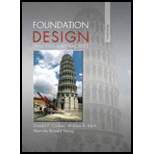
Concept explainers
A 5 ft wide, 8 ft long, 3 ft deep footing supports a downward load of 200 k and a horizontal shear load of 25 k. The shear load acts parallel to the 8 ft dimension. The underlying soils have
Learn your wayIncludes step-by-step video

Chapter 7 Solutions
Foundation Design: Principles and Practices (3rd Edition)
Additional Engineering Textbook Solutions
Starting Out With Visual Basic (8th Edition)
Starting Out with Java: From Control Structures through Data Structures (4th Edition) (What's New in Computer Science)
Computer Science: An Overview (13th Edition) (What's New in Computer Science)
Starting Out with C++ from Control Structures to Objects (9th Edition)
Starting Out with Python (4th Edition)
Concepts Of Programming Languages
- Ratio of depth to diameter d/D Q3 -A sanitary sewer is used to carry 0.12m³/sec when flowing full and conditions о 1.0 Values of fu 1.1 1.2 1.3 0.9 0.8 Manning's n 0.7 0.6 0.5 0.4 0.3 0.2 0.1 Discharge Velocity Hydraulic properties of cicular sewers 0.1 0.2 0.3 0.4 0.5 0.6 0.7 0.8 0.9 1.0 1.1 Hydraulic elements and full such as minimum flow velocity must be applied. Determine the commercial pipe size that must be used and the gradearrow_forwardFor the tower shown in Figure (2), check the suitability of the proposed piled foundation with the following infiormation: (minimum safety factor against failure is (2). (neglect the group action), (V - 2250 kN, including pile cap weight) and (M 4500 kN.m), the pile group consists of one central the distributed and eight piles circumference of a (6 m) diameter circle ( 45 ) degrees appart}. pile on = 1 m 8 m diameter cap 20 m Figure (2) 10 m M 0.5 m diameter bored pile -30 kPa. y= 19 kN/m² Gs-2,7 Sand Clayarrow_forwardA group of nine piles, 12 m long and 250 mm in diameter, is to be arrenged in a square form in clay soil with an average unconfined compressive strength of 60 kN/m². Work out the center to center spacing of the piles for a group effeciency factor of 1. Neglect bearing at the tip of the piles.arrow_forward
- Determine the allowable pile load capacity of the 40 cm diameter driven concrete pile shown in the Figure (1). W.T. Figure (1) K=1 6=0.750 3 m 6 m K = 2 6=0.750 5 m Loose sand Y₁ = 16 kN/m², '= 30° Soft clay Year = 18 kN/m, 2 C= 15 kN/m² Dense sand Ysat = 20 kN/m², -40°arrow_forward= The allowable working load on a prestressed concrete pile 21-m long that has been driven 356 mm (see Table 9.3a). into sand is 502 kN. The pile is octagonal in shape with D Skin resistance carries 350 kN of the allowable load, and point bearing carries the rest. Use E, = 21 x 10° kN/m², E, = 25 x 103 kN/m², p, 0.35, and = 0.62. Determine the settlement of the pile. ==arrow_forwardH.W.5: A beam section is limited to a width of 300 mm, and total depth h=500 mm, and has to resist a factored moment 405 kN.m.Calculate the required reinforcement, given f'c=28 MPa, fy=420 MPa. (As=6425mm, As'=2425 mm Ans)arrow_forward
- H.W.1: A rectangular beam has a width of 300 mm, and effective depth d=570 mm to centroid of tension steel bars. Tension steel reinforcement consist of 6628mm in two rows, compression reinforcement of 2022mm. Calculate the design moment strength of the beam, where f'c=28 MPa, fy=420 MPa. (Mu=822 kN.m Ans)arrow_forwardH.W.4: A beam section is limited to a width of 250 mm, and total depth h=550 mm, and has to resist a factored moment 307 kN.m.Calculate the required reinforcement, given f'c=21 MPa, fy=350 MPa, d'=65mm. (As=5425mm, As'=2022 mm Ans) HW5 A beam section is limited to a width of 300 mm and total denth h-500 mm and has to resistarrow_forwardH.W.3: A rectangular beam has a width of 400 mm, and effective depth d=700 mm to centroid of tension steel bars. Tension steel reinforcement consist of 4036mm in two rows, compression reinforcement of 2622mm. Calculate the design moment strength of the beam, where f'c=21 MPa, fy=420 MPa, d'=65mm. (Mu=927 kN.m Ans)arrow_forward
- H.W.4: A beam section is limited to a width of 250 mm, and total depth h=550 mm, and has to resist a factored moment 307 kN.m.Calculate the required reinforcement, given f'c=21 MPa, fy=350 MPa, d'=65mm. (As=5425mm, As'=2422 mm Ans)arrow_forwardH.W.6: Design the steel reinforcement for flexural for the beam shown in the fig. below. Given f'c=28 MPa, fy=420 MPa. D.L 100 kN/m L.L=200 kN 3 m 3 m 600 mm- A =? 300 mm.arrow_forwardThe tension member shown in the figure below must resist a service dead load of 60 kips and a service live load of 45 kips. Does the member have enough strength? The steel is A588: Fy = 50 ksi, F₁ = 70 ksi; and the bolts are 11/8 inches in diameter. Assume that A = An PL 38 x 72 оо a. Use LRFD. Determine the design strength and the factored load. Make a conclusion about the member. (Express your answers to three significant figures.) +Pn Pu = = kips kips -Select- b. Use ASD. Determine the allowable strength and required strength. Make a conclusion about the member. (Express your answers to three significant figures.) Ft Ae = P₁ = -Select- kips kipsarrow_forward
 Fundamentals of Geotechnical Engineering (MindTap...Civil EngineeringISBN:9781305635180Author:Braja M. Das, Nagaratnam SivakuganPublisher:Cengage Learning
Fundamentals of Geotechnical Engineering (MindTap...Civil EngineeringISBN:9781305635180Author:Braja M. Das, Nagaratnam SivakuganPublisher:Cengage Learning Principles of Foundation Engineering (MindTap Cou...Civil EngineeringISBN:9781337705028Author:Braja M. Das, Nagaratnam SivakuganPublisher:Cengage Learning
Principles of Foundation Engineering (MindTap Cou...Civil EngineeringISBN:9781337705028Author:Braja M. Das, Nagaratnam SivakuganPublisher:Cengage Learning Principles of Geotechnical Engineering (MindTap C...Civil EngineeringISBN:9781305970939Author:Braja M. Das, Khaled SobhanPublisher:Cengage Learning
Principles of Geotechnical Engineering (MindTap C...Civil EngineeringISBN:9781305970939Author:Braja M. Das, Khaled SobhanPublisher:Cengage Learning Principles of Foundation Engineering (MindTap Cou...Civil EngineeringISBN:9781305081550Author:Braja M. DasPublisher:Cengage Learning
Principles of Foundation Engineering (MindTap Cou...Civil EngineeringISBN:9781305081550Author:Braja M. DasPublisher:Cengage Learning



